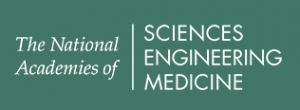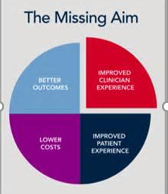NAM to tackle systemic issues damaging wellness in medicine
By John Weeks
 by John Weeks, Publisher/Editor of The Integrator Blog News and Reports
by John Weeks, Publisher/Editor of The Integrator Blog News and Reports
“Slowly and surely, we’ve been burning out a generation of doctors and nurses,” states the in the opening line of a recent American Hospital Association article. “The numbers are startling: Over 50 percent of physicians report one or more symptoms of burnout. Over 50 percent of nurses are emotionally exhausted, and 25 percent are clinically depressed … to numerous observers, the problem is getting worse.”
Addressing the causes behind the dismal world of provider burnout is the mission of a recently-announced National Academy of Medicine (NAM) committee. Prompted by the work of the Academic Collaborative for Integrative Health (ACIH) and others, NAM will sponsor a 1.5-day work shop April 26-27, 2017. The meeting will be open to the public.
 Via ACIH, the integrative health community helped instigate the project through 6 years of dialogue at the NAM’s Global Forum on Innovation in Health Professional Education. ACIH has represented integrative health values there as a sponsoring member. The integrative health field, which has promoted a health and well being focus in health care and health professional education since its inception, will be well-represented in the 16-member planning team:
Via ACIH, the integrative health community helped instigate the project through 6 years of dialogue at the NAM’s Global Forum on Innovation in Health Professional Education. ACIH has represented integrative health values there as a sponsoring member. The integrative health field, which has promoted a health and well being focus in health care and health professional education since its inception, will be well-represented in the 16-member planning team:
- Co-chair will be Mary Jo Kreitzer, PhD, RN, FAAN, the founder of the Center for Spirituality and Healing at the University of Minnesota and a member of the ACIH Council of Advisers. Her co-chair will be George Washington University’s Zohray Talib, MD.
- Kreitzer’s fellow ACIH Council of Advisers member Aviad Haramati, PhD, the Georgetown integrative medicine and founder of the CENTILE conferences on wellbeing and resilience.
- ACIH acting executive director Elizabeth A. Goldblatt, PhD, MPA/HA, and myself as a past executive director wwill each be among the other 14 members on the 16-member committee. They represent ACIH at the Global Forum as “Member” and “Alternate,” respectively.
- Philanthropic investment to enhance the initiative’s reach and impact will come through the George Family Foundation, led by Bill and Penny George. The Georges have been significant philanthropic backers of the integrative health and medicine movement through investment at Allina Health, the Bravewell Collaborative and elsewhere. They were also among the principal backers of the 2009 IOM Summit on Integrative Medicine and the Health of the Public.
Expanding the initiative’s anticipated impact is that the workshop will be developed in collaboration with a separate initiative created by National Academies of Science president, Victor Dzao, MD. Dzau founded the physician centric “Action Collaborative on Physician Well-being and Resilience.” The work of that collaborative will feed into the April 2018 workshop through additional planning committee members. These will join the set from the intensely interprofessional Global Forum, in which virtually all professions are represented.
The workshop was announced in a webinar on May 17, 2017 sponsored by ACIH and led by Global Forum member Patricia Cuff, MPP. On the Global Forum website, the beginning of the planning committee’s mission is posted. “The committee will seek to identify examples drawn from around the world that demonstrate how different professions cope with the stresses of educating health professionals under current health and educational structures, and how adjustments in policies and incentives might move organizations to adopt a more welcoming environment for testing and implementing individual stress-reduction and resilience-building strategies,” it reads.
If you have good examples, I would be happy to pass them forward. The recording of the ACIH webinar is available here.
 Comment: When ACIH took the leap to commit to becoming one of the sponsoring organizations of the Global Forum in early 2012, the ACIH board made clear in its charges to Goldblatt and me representatives: promote any “innovation” relative to health and wellbeing. Many rivers, including the growing burnout noted at the top of this article, and the inclusion of practitioner experience in the Quadruple Aim, have converged to put this workshop in play.
Comment: When ACIH took the leap to commit to becoming one of the sponsoring organizations of the Global Forum in early 2012, the ACIH board made clear in its charges to Goldblatt and me representatives: promote any “innovation” relative to health and wellbeing. Many rivers, including the growing burnout noted at the top of this article, and the inclusion of practitioner experience in the Quadruple Aim, have converged to put this workshop in play.
The issues are significant. In the Global Forum’s most recent planning meeting, on April 5, 2017, a discussion opened on just one of stress-producing topic—the historic, top-down, physican-led hierarchy that typically defines delivery of care. While working as underlings in sometimes abusive relationships with medical doctors is known to be a factor in burnout and depression among nurses, Goldblatt alluded to its impact on medical doctors.
“The hierarchical stress is one of the issues in the multiple pressures creating stress and burnout,” she said. “Part of the challenge is the hierarchy of the industry. It would be very beneficial if [medical doctors] became more interprofessional.”
Goldblatt’s point was quickly taken up by other Forum members. One noted “anecdotal experience” with a multi-year interprofessional project that it does “create relief” when medical students in interprofessional environments begin to realize that patient care is not their sole responsibility. Another note that “at least part of the solution [to creating well being and resilience] can be in team-based collaborative care.”
















